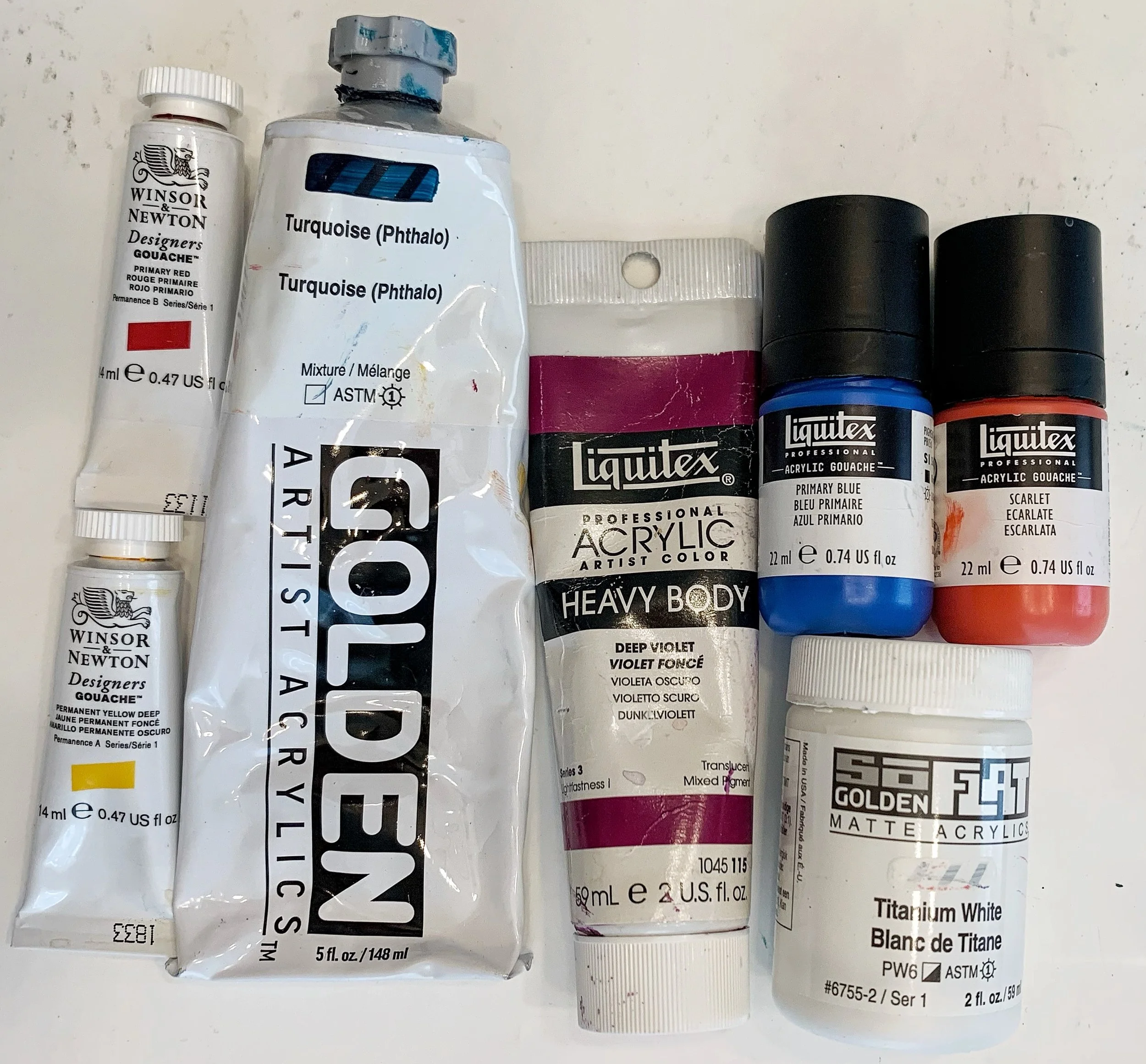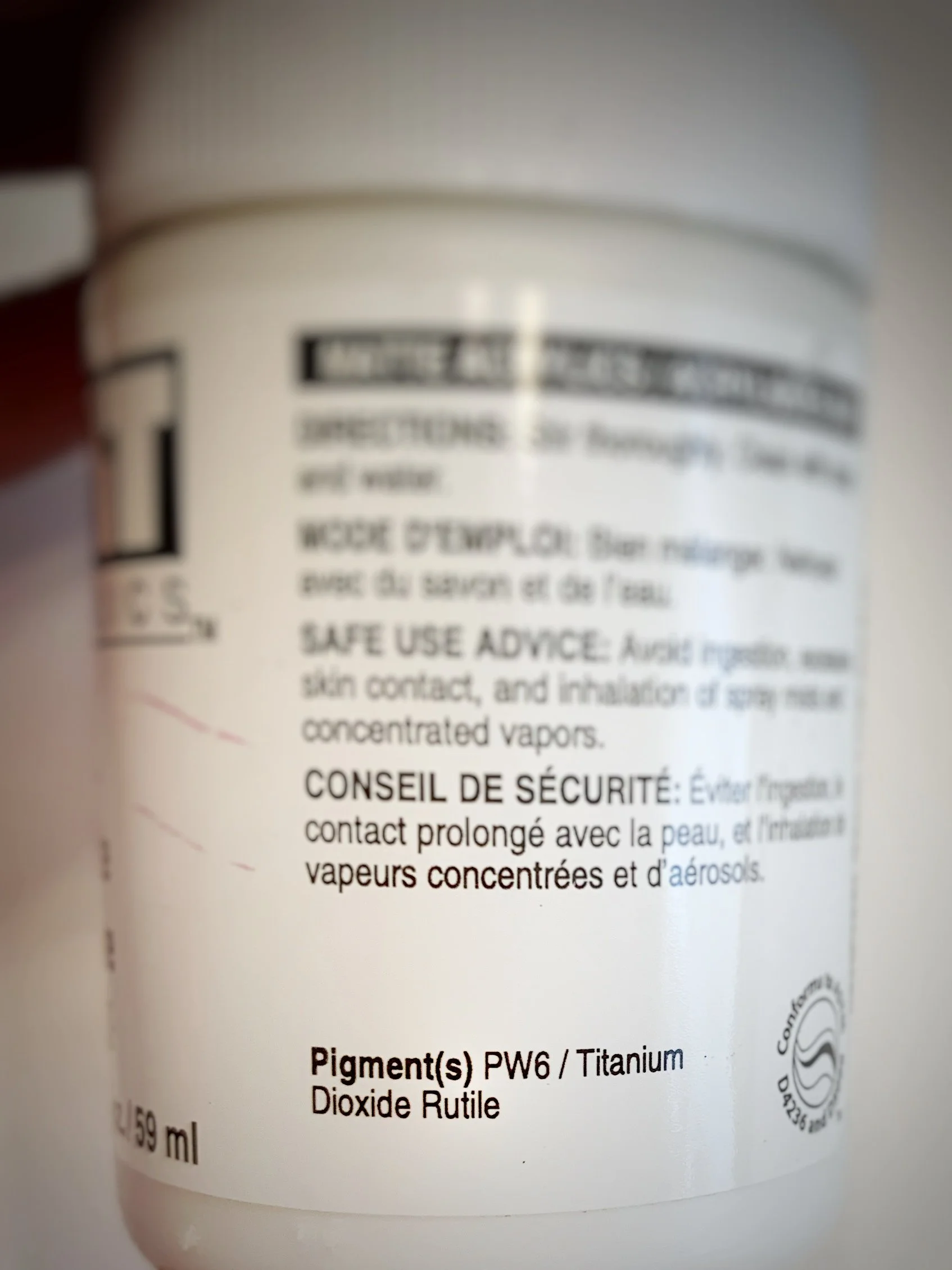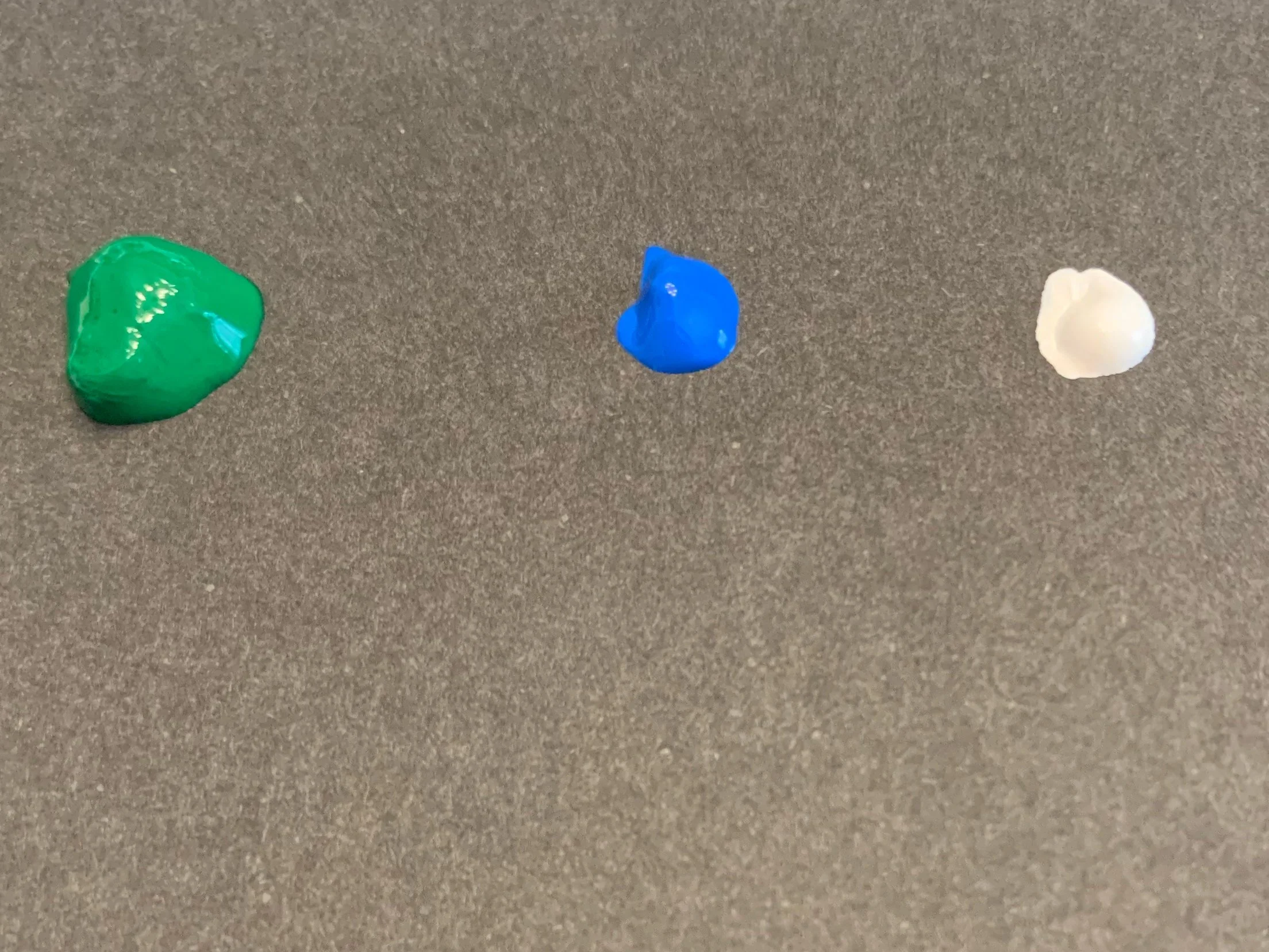Gouaches
Detail of a floral sketch in acrylic gouache. | Abril Warner, 2024
Determining and assessing the differences in quality, performance, and overall suitability between types of paints depends on the artist’s medium preference and painting style. This comparison will focus on traditional gouache (Winsor & Newton’s Designers Gouache) and acrylic gouache (Golden SoFlat and Liquitex Acrylic Gouache), based mainly on my findings and preferences. To begin, it's important to understand the definitions of both gouache and acrylic paint.
In the most basic terms, gouache is a water-soluble paint with similar qualities to watercolor except that gouache is generally opaque. Like watercolor, gouache is bound with gum arabic and gouache is mixed with water, and is primarily applied to paper. Acrylic paints, on the other hand, are made from pigments bound with synthetic resin and have a broader range of versatility in hues, finishes, and applications than gouache. Specifically, acrylic gouache, or matte acrylic paints, have a matte finish just like traditional gouache. To understand the nuances, we will consider several aspects of each: traditional gouache and acrylic gouache.
An array of paints from gouache to heavy body acrylics to acrylic gouache (left to right). | Abril Warner, 2025
Pigment & Price
The beauty of gouache lies in its opacity and matte finish, which enhances the vibrancy of the pigments and ensures they are easy to see without any glare. However, some pigments are naturally glossy or transparent and require opacity modifiers. The two most common methods for achieving opacity in gouache are adding calcite or increasing the pigment concentration. Generally, more expensive gouache brands have a higher pigment load, resulting in greater opacity or semi-opacity per tube. In contrast, cheaper brands often use chalk and other additives to achieve the desired opaque and matte finish. Colors with higher pigment loads tend to dry more vibrantly, while those with lower pigment loads dry with a chalkier appearance. Both effects can be desirable depending on the artist’s needs.
Matte acrylic paints have the same finish as a gouache paint which is great opacity, matte surface and vibrancy. The pigment loads also correspond to the varying price points and opacity. Understanding the pigment index is helpful for color mixing, particularly when working with multiple brands. It's important not to rely solely on the color names provided by the manufacturer. Reputable paint companies typically list both the color name and the specific pigments used on the label, and this information is often available on their website as well.
The chart below demonstrates how three paint companies use the same pigment. Two manufacturers chose the same name and the same pigment variant which is the warmer or redder version of the organic compound known as phthalocyanine blue, while Golden chose a different name and the greener aspect of the same pigment. (1, 2, 3)
(above) Chart demonstrating how paint names and pigments might vary.
(below) Paint labels where pigment information can be found.
Chart comparing the cost of three paint companies’ versions of Quinacridone Magenta. (4) | Abril Warner, 2025
The Designers Gouache contains a smaller amount of paint, but keep in mind that it must be diluted with water before use. In contrast, the acrylic versions, such as those from Liquitex and Golden, are ready to use and do not require any additives. All three companies are well-regarded for their high pigment load and consistent quality across their professional paint lines. When the water-to-paint ratio is correct, gouache typically provides strong opacity even on the first layer. However, Quinacridone Magenta is a semi-transparent pigment and will naturally require more layering compared to more opaque colors. It's also important to note that prices can vary within each brand’s color line due to differences in pigment costs.
Opacity, Viscosity & Finish
To repeat for clarity, the inherent nature of the pigment determines the starting point of a paint color’s opacity and shininess. Additives, including the amount of water used, can further affect the final result. That said, both gouache and acrylic gouache are formulated to achieve complete coverage and a flat, sheen-free surface. Now, let’s take a closer look at the texture and finish of these paints.
A drop of Designers Gouache green, a drop of Liquitex Acrylic Gouache blue, and a drop of Golden SoFlat white. (left to right). | Abril Warner, 2025
Most gouache comes in tubes, though it is also available in cakes and gels. This means the paint is typically thick and requires some preparation—such as squeezing it out, mixing with a brush or palette knife, and adding water. Additives like gum arabic or glycerin can be used to improve workability. These are often added to extend drying time or increase the flexibility of the paint, as gouache can flake or crack when dry. When used carefully, such additives generally do not affect the flat, matte finish that gouache is known for. However, if too little water is used, the paint may dry with an undesired shiny surface.
Acrylic gouache, such as those from Liquitex and Golden, is usually sold in small tubs or jars. The Liquitex Acrylic Gouache and Golden SoFlat lines are only slightly thicker than their respective fluid acrylics, and are significantly less viscous than their heavy body versions. Liquitex promotes its Acrylic Gouache as professional-grade paint that delivers a smooth, brushstroke-free, sheen-free, and crack-resistant finish in a range of fifty colors. Golden’s SoFlat line offers a broader color range with varying degrees of opacity and sheen, and layering can sometimes increase the surface shine. Both companies allow their acrylic gouache to be mixed with other acrylic lines, but the use of additives may alter the paint’s flatness and matte quality. Liquitex and Golden both provide detailed spec sheets and color charts, which are useful tools for mixing, selecting, and understanding their products. (1, 2)
Working & Drying Time
Traditional gouache and acrylic gouache can both be used to cover large areas, but the paint tends to settle and flatten as it dries. Traditional gouache evaporates quickly from both the palette and the painting surface, making brush loading for extended use something that takes practice. Both types of paint dry quickly, which can be a challenge—especially for those used to oil painting, where the longer working time allows for more blending. The fast-drying time is even more pronounced in gouache than in acrylics.
One of the key differences between the two is that acrylic matte paint, like its heavy body counterpart, dries permanently. In contrast, traditional gouache can be rehydrated, and therefore be reactivated with water even after it has dried.
To achieve a flat, matte finish with paints like Liquitex Acrylic Gouache and Golden SoFlat, it’s best to allow each layer to dry completely before applying the next. When applied this way, the dry lower layers remain stable, and the coverage of each new layer will depend on the color’s opacity.
With traditional gouache, layering should also be done by applying wet paint to dry layers. However, the longer and more forceful the brushwork during application, the more water is absorbed by the underlying layer, reactivating it. For example, if a red layer is applied and allowed to dry, and a white stroke is added over it, the red may lift into the white, creating a pink tint instead of a clean, opaque white. Even if more white is added on top, a faint trace of the red may remain, as pigment from the lower layer is drawn up by the water. This quality of reactivation is frustrating to some, but it can be useful for correcting surface irregularities or making subtle adjustments.
Gouache
Red with white on top. Top stripe has two white layers.
Acrylic Gouache
Crimson with white on top. Lower stripe has two white layers. Note: the lower white is lumpy because I did not wait for complete drying between layers.
Color Shift & Lightfastness
Color shift refers to the change in value that occurs as paint dries, typically appearing lighter when wet and darker once dry. This is most often caused by the binder, which looks milky or whitish when wet but becomes clearer as it dries. As a result, the perceived color can change, and artists need to account for this in their work. I make swatches of all the colors I use and take notes on them, though some artists are able to sight-match colors instinctively, much like musicians who play by ear.
In my experience, both as a student and now, high-quality traditional gouache shows little to no noticeable color shift. Similarly, with Liquitex Acrylic Gouache and Golden SoFlat paints, I have not found color shift to be a concern. Based on several reviews and an article, there seems to be a general consensus that these paints do not show a significant difference in value between their wet and dry states (5).
Picture of wet and dry Liquitex Acrylic Gouache blue.
Lightfastness refers to a color’s resistance to fading when exposed to light. A high lightfastness rating indicates that the paint will hold its color well over time, which is especially important for work intended to last.
Most of Winsor & Newton’s Designers Gouache colors are rated high for lightfastness, though a few are rated as moderate—such as Alizarin Crimson—or even fugitive, like Opera Pink. Golden SoFlat paints generally range from excellent to very good in lightfastness, though their fluorescent colors are not lightfast. Liquitex Acrylic Gouache is made with archivally rated pigments, but, like Golden, Liquitex notes that some pigments—particularly fluorescents—are not rated. In practical terms, this means they are not lightfast and should be used with that limitation in mind. (1, 2)
Smells
The only other noticeable difference I can speak to is the smell—both traditional gouache and acrylic gouache have an odor, but I find that the Liquitex and Golden matte paints have a stronger, more chemical smell compared to the more water-soluble traditional gouache. A cursory search revealed that acrylics and other water-soluble paints often include additives to prevent bacterial growth, which may be the source of the odor. Since, I do not find it impossible to work with the smell, I did not investigate exactly which chemicals are used in these formulations. Once the paintings dry I do not detect this smell.
Which is best?
The question is not appropriate since the artist’s preference and use must be considered. I will use both types of matte paints, but more intentionally.
At a recent art festival, I approached an artist whose stunning paintings looked almost like digital matte prints. Curious about their process, I asked how the effect was achieved. It turned out to be quite involved—using fluid acrylics, carefully mixed mediums, blow drying, sanding, and multiple layers of matte varnish. When they mentioned that their preferred brands were Liquitex and Golden, I asked if they were familiar with the Acrylic Gouache and SoFlat lines from those same companies. They weren’t—but were immediately intrigued and wrote down the names to look into them further.
Sources:
1. Liquitex Acrylic Gouache colors
3. Winsor & Newton Gouache colors
4. BLICK prices











